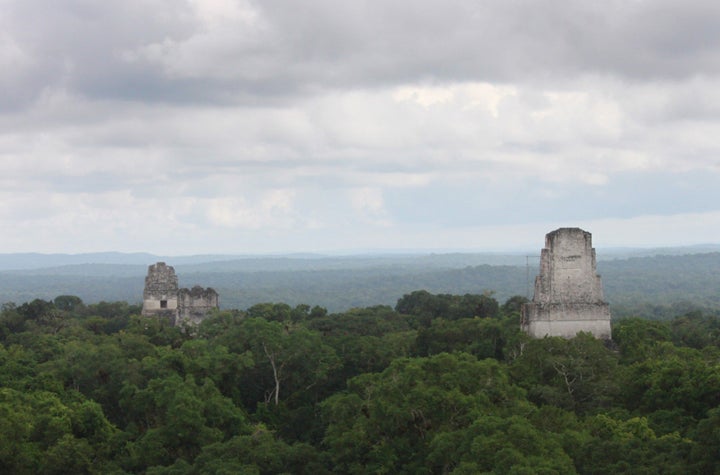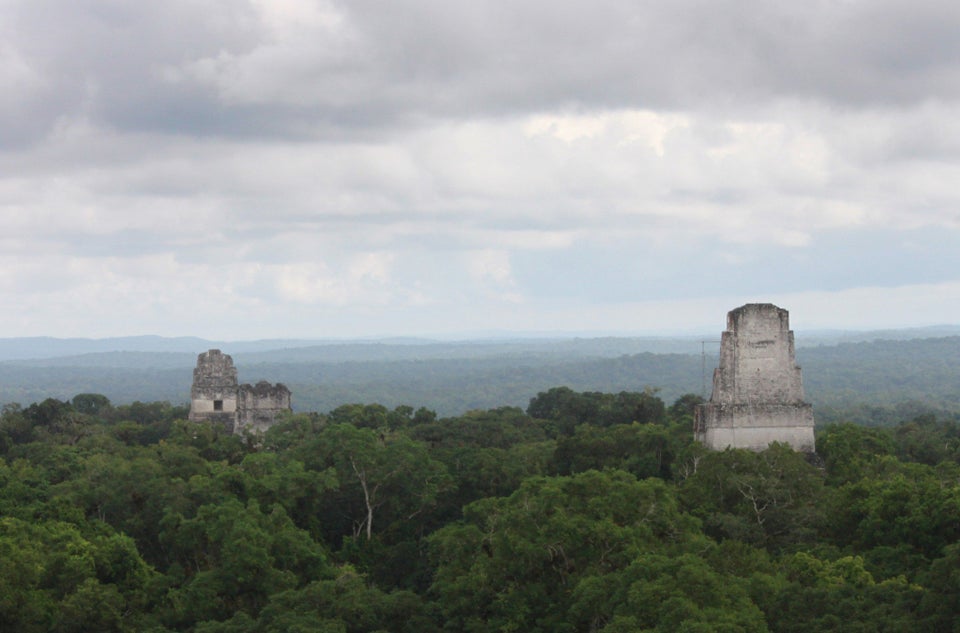
The day I cross the border from Belize at Benque the man hawking newspapers from a moped in La Maquina is shouting into his bullhorn that John McAfee has been extradited to Miami. La Maquina is a small Guatemalan town and no one seems moved by the news, the narrative of a single man's bath salt-fueled insanity paling in comparison to a couple of frenetic millennia that saw the ambitions of the Maya empire written in stone then eroded by a tidal wave of Old World Catholic violence.
The towns along CA13, which leads microbuses full of tourist to Tikal, sit in a rolling landscape cut into pieces by slash and burn farming. Men carry sacks of black beans on their backs and women carry laundry on their heads down to Lake Salpeten Macanche, which is on schedule to release its annual sulfurous burp in the next few weeks if dead fish are any indication.
This is exactly the sort of country that tourists never go through, in that it is poor, rural, full of gun-toting military types, and inside Guatemala, a country that is gaining a reputation as Mexico's Mexico. Travelers wander through here because this is how to get to Tikal and, by God, people want to get to Tikal.
The first thing I notice as our minivan drives up to the entrance to Parque Nacional Tikal is that the vaulted gate is profoundly reminiscent of Jurassic Park. The forest beyond is as well. As we buy passes, no one will check from guards who look exhausted despite the fact that it is just after nine in the morning, I watch a man with a distinctly Maya face slowly release a rope that allows a cantilevered weight to pivot the gate arm blocking our path. His eyes are narrowed and he stands with his weight held evenly between his feet.
I'm certain I couldn't knock him over if I tried, not that I had any urge to do so.
Looking up the two pyramids that dominate Tikal's Gran Plaza, it is impossible not to wonder how many men like the gatekeeper helped build this city, which dominated the region during the Maya's Classic period around A.D. 300. The answer is, of course, lots. When it comes to archaeology, estimates are expressed in ranges, and when it comes to Tikal the best estimates generally come at the top of the ranges. Miles of causeways once linked the clusters of temples and buildings here, and may have penetrated deep into the forest.
The site is impressive not just because it is big -- it is large enough that I got lost for a good half an hour without running into any other visitors -- but because of the way its largeness interacts with the hugeness of its environs. The trees here, specifically the few remaining mahoganies, are massive. The noise of the howler monkeys is occasionally deafening. Ocellated turkeys crash through the underbrush.
The only way to take in all of this size is to climb Temple IV, the 230 foot testament to the successful reign of Yik’in Chan Kawil, otherwise known as Kawil, that darkens the sky. The view over the canopy from the top is so deeply embedded in our pop culture that a graduate student studying Meso-American archaeology told me after his tour he was excited to have seen "the 'Star Wars' view." Specifically, he was excited to see the Rebel Base on Yavin 4 in "Episode IV: A New Hope." As I sat at the top, a group of Guatemalan boy scouts posed for a seemingly endless number of pictures, this being their Mount Rushmore.
At around three, Tikal starts clearing out. Tourists not staying in the hostels of El Remate need to make it to the border before customs closes. The emptiness is both romantic and hazardous: Stepping into a dark room in Grupo G, I was confronted by a wall of sparrows who sent me skidding to the ground.
By four there are few non-Guatemalans left. The group I'd come over with was long since gone and local families -- boys in sleeveless shirts and girls in kitten heels -- massed around the visitors center to drink cappuccinos and chat. The only news here was the old news, the very old news, that the world would end on December 21 and that there would be a celebration at Tikal to send the planet off in style. Native Americans of many stripes are to arrive and intermingle, hopefully without the hostility of eons past.
If history does, in fact, end, the smart money is on Tikal's survival. Like history's great paperweight, these temples will stubbornly refuse to move. No amount of craziness can change that.
